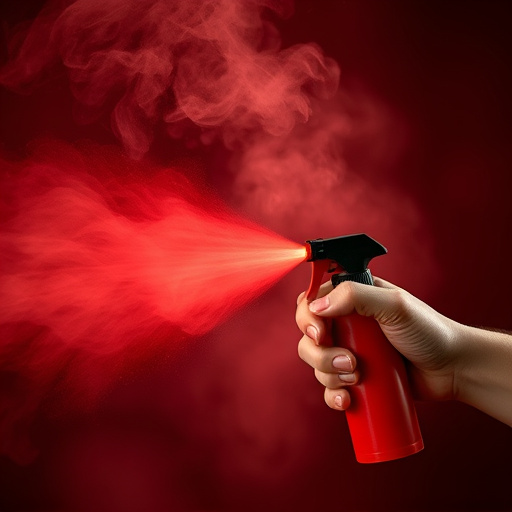Despite popular belief, pepper spray remains effective against attackers during rainy conditions thanks to water-resistant formulations. Its active ingredient, capsaicin, disrupts senses through pain receptors, offering a reliable defense mechanism. Recent advancements in formula and delivery systems have improved its performance under rain-related conditions, ensuring better contact with targets' eyes and respiratory system. Future innovations aim to enhance its effectiveness in wet weather through water-resistant coatings, smart sensors, and adjusted spray patterns, making pepper spray a trustworthy choice for outdoor scenarios with unexpected weather changes.
In today’s world, self-defense products like concentrated pepper extract are gaining popularity. While pepper spray is renowned for its effectiveness, its performance in wet environments, especially during rainy conditions, presents a challenge. This article delves into the science behind pepper spray’s effectiveness and explores strategies to enhance its performance under moist circumstances. We also discuss future innovations aimed at revolutionizing pepper spray use in rain, addressing crucial considerations for personal safety.
- Understanding Concentrated Pepper Extract Defense Products
- The Science Behind Pepper Spray Effectiveness
- Challenges in Using Pepper Spray in Rainy Conditions
- Strategies to Enhance Pepper Spray Performance in Wet Environments
- Future Innovations and Improvements for Pepper Spray in Rain
Understanding Concentrated Pepper Extract Defense Products
Concentrated pepper extract defense products, often known as pepper spray, have gained significant popularity for personal safety. These products contain capsaicin, the active ingredient derived from chili peppers, which temporarily disables an attacker by causing intense pain and irritation in the eyes, nose, and throat. The effectiveness of pepper spray is well-documented, especially in various weather conditions, including rain. Interestingly, while rain might seem like a challenge for its performance, studies show that pepper spray retains its potency even in wet environments. This is due to its non-water-soluble nature, ensuring the active compounds remain effective against assailants.
The Pepper Spray Effectiveness in Rain is not just theoretical; it’s backed by real-world applications. Law enforcement agencies and individuals alike rely on these products for self-defense, knowing that they can be used with confidence in various settings. Moreover, advancements in formulation have led to improved water resistance, making them even more reliable in unexpected weather changes or outdoor scenarios.
The Science Behind Pepper Spray Effectiveness
The effectiveness of pepper spray, a popular self-defense product, relies on its active ingredient—capsaicin, the compound that gives peppers their heat and sting. When used against an attacker, capsaicin irritates the eyes, nose, and throat by binding to pain receptors, causing a temporary but intense burning sensation. This disruption can help individuals gain precious time to escape or call for assistance.
In various environmental conditions, pepper spray’s performance remains robust, even in the rain. Water-resistant formulations ensure that the spray retains its potency when used outdoors. The tiny droplets of capsaicin oil are designed to stay airborne and adhere to an attacker’s skin or clothing, providing a reliable defense mechanism regardless of weather conditions, including rain. This feature makes pepper spray a versatile self-defense tool for outdoor activities and situations where encountering hostile individuals is a concern.
Challenges in Using Pepper Spray in Rainy Conditions
Using pepper spray in rainy conditions presents unique challenges that can impact its effectiveness. Water is a formidable enemy for any chemical agent, as it dilutes and dissipates the active ingredients. Pepper spray relies on irritants to create a temporary yet intense disruption, but rain can quickly dilute these compounds, reducing their potency. The wet environment can also affect the user’s visibility and handling of the spray, making accurate application more difficult.
Moreover, the atmospheric conditions in rainy weather can alter how pepper spray disperses. Raindrops act as tiny carriers, potentially spreading the irritants over a larger area than intended, which may not always achieve the desired defensive effect. Despite these challenges, advancements in formula and delivery systems continue to improve pepper spray’s performance under various climatic conditions, including rain.
Strategies to Enhance Pepper Spray Performance in Wet Environments
In wet environments, pepper spray’s effectiveness can be significantly reduced due to water’s ability to dilute and disperse the active ingredients. To overcome this challenge, manufacturers have developed advanced strategies to enhance its performance in rain or other humid conditions. One approach is to increase the concentration of capsaicin, the primary irritant in pepper spray, ensuring a stronger impact despite moisture.
Additionally, incorporating water-resistant formulations and using specialized delivery mechanisms can improve projection and penetration. These innovations allow for better contact with the target’s eyes and respiratory system, even when the spray encounters water droplets. As a result, users can maintain optimal protection during outdoor activities or in wet weather conditions, ensuring pepper spray remains an effective defense tool in various environments, including rainy ones.
Future Innovations and Improvements for Pepper Spray in Rain
As technology advances, future innovations in pepper spray design will likely focus on enhancing its effectiveness in challenging conditions, including rainy weather. One area of improvement could be developing water-resistant formulations that maintain their potency and projection range despite moisture. Researchers might explore incorporating advanced coatings or chemical compounds that provide a stronger bond between the spray and targeted areas, ensuring the active ingredients remain active longer.
Additionally, integrating smart sensors and delivery systems could revolutionize pepper spray’s performance in rainy environments. These devices could detect specific conditions, such as high humidity or rain, and automatically adjust spray patterns and intensity to maximize effectiveness. Such adaptations would ensure that law enforcement officers and individuals have a reliable self-defense mechanism even during adverse weather, improving overall safety and security measures.
In conclusion, while pepper spray has proven to be an effective self-defense tool, its performance in rainy conditions presents challenges. Understanding the science behind its effectiveness and exploring strategies to enhance its performance in wet environments, such as improving formulations and application techniques, are crucial steps towards ensuring optimal defense in diverse scenarios, including those with high moisture content like rain. Future innovations in pepper spray technology, focusing on weather-resistant formulations, could revolutionize personal safety, especially in the world of self-defense against unpredictable attacks.
